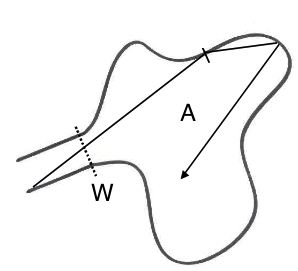The region $Y$ introduces a delay time $\tau$, the average time between entry and exit. Let me first consider the case that the dynamics in the two-dimensional region $Y$ is a Brownian motion (diffusion) with diffusion coefficient $D$. The region $Y$ has area $A$, perimeter $P$, and $W$ is the width of the tunnel. The mean time between collisions with the perimeter of $Y$ can be estimated as $A/D$, and on average about $P/W$ collisions occur between entry and exit, so we have the estimate
$$\tau=C\times\frac{AP}{DW}.\quad\quad[1]$$
The shape dependence enters in the coefficient $C$ of order unity, but different shapes with the same area and perimeter will have the same $\tau$ in order of magnitude.

We can do better and obtain a precise expression for $\tau$ including the numerical coefficient, if we assume that $Y$ is a billiard, in which the particle moves along a straight line (velocity $v$), bouncing from the walls until it finally exits. (See diagram.) This problem has been analyzed by Lewenkopf and Vallejos under the assumption of ``weak ergodicity'', which basically means that the particle explores the whole phase space of the billiard before exiting. (This assumption is weaker than that of chaotic dynamics, it also applies to, say, a circular billiard which has regular dynamics.) Under this assumption one has simply
$$\tau=\frac{\pi A}{vW}\quad\quad [2]$$
without any shape dependence.
The assumption of a constant velocity is actually not needed, if only the energy $E$ of the particle is constant but its velocity varies, then one has
$$\tau=\frac{1}{\tilde{\Omega}}\frac{d\Omega}{dE}\quad\quad [3]$$
where $\Omega$ is the area of phase space in the billiard and $\tilde{\Omega}$ the area of phase space connected to the tunnel. The simpler expression $\tau=\pi A/vW$ for constant velocity (momentum $p=mv$) follows from $\Omega=\pi p^2 A=2\pi mE A$ and $\tilde{\Omega}=2pW$. In this way one also obtains the generalization to a three-dimensional billiard (volume $V$) connected to a tunnel with cross-sectional area $S$:
$\Omega=\frac{4}{3}\pi p^3 V=\frac{4}{3}\pi(2mE)^{3/2}V$ and $\tilde{\Omega}=\pi p^2 S$,
so
$$\tau=\frac{1}{\tilde{\Omega}}\frac{d\Omega}{dE}=\frac{4V}{vS},\quad \quad[4]$$
again without any shape dependence.

